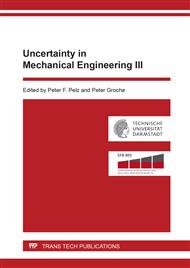[1]
B Endelt. Design strategy for optimal iterative learning control applied on a deep drawing process. International Journal of Advanced Manufacturing Technology, 88(1):3-18, (2017).
DOI: 10.1007/s00170-016-8501-z
Google Scholar
[2]
B. Endelt. Designing an iterative learning control algorithm based on process history - using limited post- process geometrical information. In Proceedings of the IDDRG 2017 Conference, (2017).
Google Scholar
[3]
B. Endelt and J. Danckert. Iterative learning and feedback control applied on a deep drawing process. International Journal of Material Forming, 3(SUPPL. 1):25-28, (2010).
DOI: 10.1007/s12289-010-0698-z
Google Scholar
[4]
B. Endelt and W. Volk. Designing an iterative learning control algorithm based on process history using limited post- process geometrical information. In Proceedings of the IDDRG 2013 Conference, Best in Class Stamping, 2013. submitted for presentation at the IDDRG 2013 Conference.
Google Scholar
[5]
Benny Endelt, Søren Tommerup, and Joachim Danckert. A novel feedback control system - controlling the material flow in deep drawing using distributed blank-holder force. Journal of Materials Processing Technology, 213(1):36 - 50, (2013).
DOI: 10.1016/j.jmatprotec.2012.08.003
Google Scholar
[6]
Jörg Heingärtner, Anja Neumann, Dirk Hortig, Yasar Rencki, and Pavel Hora. Acquisition of material properties in production for sheet metal forming processes. In AIP Conference Proceedings, volume 1567, pages 671-674. AIP, (2013).
DOI: 10.1063/1.4850061
Google Scholar
[7]
Yongseob Lim, Ravinder Venugopal, and A. Galip Ulsoy***. Advances in the control of sheet metal forming. In Proceedings of the 17th World Congress The International Federation of Automatic Control, (2008).
Google Scholar
[8]
Sy-Wei Lo and Tsu-Chang Yang. Closed-loop control of the blank holding force in sheet metal forming with a new embedded-type displacement sensor. The International Journal of Advanced Manufacturing Technology, 24(7-8):553-559, (2004).
DOI: 10.1007/s00170-003-1711-1
Google Scholar
[9]
James A. Polyblank, Julian M. Allwood, and Stephen R. Duncan. Closed-loop control of product properties in metal forming: A review and prospectus. Journal of Materials Processing Technology, 214(11):2333 - 2348, (2014).
DOI: 10.1016/j.jmatprotec.2014.04.014
Google Scholar
[10]
K. Siegert, M. Ziegler, and S. Wagner. Closed loop control of the friction force. deep drawing process. Journal of Materials Processing Technology, 71(1):126-133, (1997).
DOI: 10.1016/s0924-0136(97)00158-1
Google Scholar


